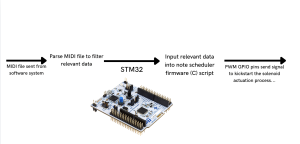At the beginning of this week, I helped polish the Proposal Presentation slides. Specifically, I worked on defining the technical challenges (both hardware and software), specifying testing methodology + performance metrics for different parameters (accuracy, eye-tracking detection latency, solenoid latency, and power consumption) and contributed to shaping the overall structure of the Gantt chart. I also participated in preparing Fiona for the oral presentation; Peter and I spent about 2 hours to help her practice her public speaking skills as well as refine her script after seeing the first round of presentations on Monday.
I began research on the power management system for the solenoids, which is critical for ensuring stable and efficient operation. Since solenoids require precise voltage and current control, I’ve been exploring different power management circuits and components.
In order to integrate Low Dropout Regulators (LDOs) -a type of linear voltage regulator- into our solenoid power management system, I have been studying the LM7805 in particular. Our case is such that the input voltage is only marginally higher than the intended output voltage, which is a perfect fit for LDOs. This is essential to guarantee that the solenoids receive a steady, uniform voltage; variations may cause irregular key presses or deterioration of the solenoids over time.
I’ve also decided that it would be beneficial to include decoupling capacitors in our custom PCB to stabilize the voltage supply and prevent noise that could affect solenoid performance. This is a very standard practice for PCB design.
Moving forward, I need to narrow down the specific components for the solenoid control circuit and run initial simulations to ensure everything will function as expected. These simulations can be done in Cadence Virtuoso ADE. I can start by running transient analysis to simulate how the voltage and current evolve over time, especially as the solenoid is actuated. It’s important I simulate a single solenoid actively pressing as well MULTIPLE solenoids simultaneously pressing, as we are going to be implementing chord functionality (up to three simultaneous notes).
The waveform viewer will also be useful to check for any instability (e.g., fluctuating voltage or high power dissipation). For my simulation data to be useful, I need to first know which particular solenoid components we plan to order (I need to make sure the current and output voltage from regulator don’t exceed solenoid’s maximum ratings). Thus, I suppose one dependency I have here is for Peter to finalise some preliminary component selections as he is the one in charge of selecting which solenoids we will use.
We will also be working on the design review presentation this upcoming week.
I am on schedule at the moment, but I’m aware that this is the point in the semester that the project starts to get busy as we are going to begin with the true, hands-on engineering.


